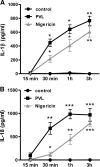Staphylococcus aureus Panton-Valentine leukocidin induces an inflammatory response in human phagocytes via the NLRP3 inflammasome
- PMID: 22892107
- PMCID: PMC3476237
- DOI: 10.1189/jlb.0112014
Staphylococcus aureus Panton-Valentine leukocidin induces an inflammatory response in human phagocytes via the NLRP3 inflammasome
Abstract
The Staphylococcus aureus pore-forming toxin PVL is most likely causative for life-threatening necrotizing infections, which are characterized by massive tissue inflammation and necrosis. Whereas the cytotoxic action of PVL on human neutrophils is already well established, the PVL effects on other sensitive cell types, such as monocytes and macrophages, are less clear. In this study, we used different types of human leukocytes (neutrophils, monocytes, macrophages, lymphocytes) to investigate cell-specific binding of PVL subunits and subsequent proinflammatory and cytotoxic effects. In all PVL-sensitive cells, we identified the binding of the subunit LukS-PV as the critical factor for PVL-induced cytotoxicity, which was followed by binding of LukF-PV. LukS-PV binds to monocytes, macrophages, and neutrophils but not to lymphocytes. Additionally, we showed that PVL binding to monocytes and macrophages leads to release of caspase-1-dependent proinflammatory cytokines IL-1β and IL-18. PVL activates the NLRP3 inflammasome, a signaling complex of myeloid cells that is involved in caspase-1-dependent IL-1β processing in response to pathogens and endogenous danger signals. Specific inhibition of this pathway at several steps significantly reduced inflammasome activation and subsequent pyronecrosis. Furthermore, we found that PAMPs and DAMPs derived from dying neutrophils can dramatically enhance this response by up-regulating pro-IL-1β in monocytes/macrophages. This study analyzes a specific host signaling pathway that mediates PVL-induced inflammation and cytotoxicity, which has high relevance for CA-MRSA-associated and PVL-mediated pathogenic processes, such as necrotizing infections.
Figures










Similar articles
-
Cross-talk between Staphylococcus aureus leukocidins-intoxicated macrophages and lung epithelial cells triggers chemokine secretion in an inflammasome-dependent manner.Cell Microbiol. 2012 Jul;14(7):1019-36. doi: 10.1111/j.1462-5822.2012.01772.x. Epub 2012 Mar 5. Cell Microbiol. 2012. PMID: 22329718
-
α-Defensins partially protect human neutrophils against Panton-Valentine leukocidin produced by Staphylococcus aureus.Lett Appl Microbiol. 2015 Aug;61(2):158-64. doi: 10.1111/lam.12438. Epub 2015 Jun 1. Lett Appl Microbiol. 2015. PMID: 25963798
-
Targeting NLRP3 and Staphylococcal pore-forming toxin receptors in human-induced pluripotent stem cell-derived macrophages.J Leukoc Biol. 2020 Sep;108(3):967-981. doi: 10.1002/JLB.4MA0420-497R. Epub 2020 Jun 12. J Leukoc Biol. 2020. PMID: 32531864
-
Bacterial two-component and hetero-heptameric pore-forming cytolytic toxins: structures, pore-forming mechanism, and organization of the genes.Biosci Biotechnol Biochem. 2004 May;68(5):981-1003. doi: 10.1271/bbb.68.981. Biosci Biotechnol Biochem. 2004. PMID: 15170101 Review.
-
Panton-Valentine leukocidin-positive Staphylococcus aureus: a position statement from the International Society of Chemotherapy.Int J Antimicrob Agents. 2018 Jan;51(1):16-25. doi: 10.1016/j.ijantimicag.2017.11.002. Epub 2017 Nov 22. Int J Antimicrob Agents. 2018. PMID: 29174420 Review. No abstract available.
Cited by
-
Leukocidins and the Nuclease Nuc Prevent Neutrophil-Mediated Killing of Staphylococcus aureus Biofilms.Infect Immun. 2020 Sep 18;88(10):e00372-20. doi: 10.1128/IAI.00372-20. Print 2020 Sep 18. Infect Immun. 2020. PMID: 32719153 Free PMC article.
-
Quorum Sensing and Toxin Production in Staphylococcus aureus Osteomyelitis: Pathogenesis and Paradox.Toxins (Basel). 2020 Aug 12;12(8):516. doi: 10.3390/toxins12080516. Toxins (Basel). 2020. PMID: 32806558 Free PMC article. Review.
-
Exploring the Role of Staphylococcus aureus in Inflammatory Diseases.Toxins (Basel). 2022 Jul 6;14(7):464. doi: 10.3390/toxins14070464. Toxins (Basel). 2022. PMID: 35878202 Free PMC article. Review.
-
Exploration of compounds to inhibit the Panton-Valentine leukocidin of Staphylococcus aureus.Med Microbiol Immunol. 2024 Sep 19;213(1):19. doi: 10.1007/s00430-024-00803-1. Med Microbiol Immunol. 2024. PMID: 39297970 Free PMC article.
-
Structurally designed attenuated subunit vaccines for S. aureus LukS-PV and LukF-PV confer protection in a mouse bacteremia model.PLoS One. 2013 Jun 7;8(6):e65384. doi: 10.1371/journal.pone.0065384. Print 2013. PLoS One. 2013. PMID: 23762356 Free PMC article.
References
-
- Lowy F. D. (1998) Staphylococcus aureus infections. N. Engl. J. Med. 339, 520–532 - PubMed
-
- Kaneko J., Kamio Y. (2004) Bacterial two-component and hetero-heptameric pore-forming cytolytic toxins: structures, pore-forming mechanism, and organization of the genes. Biosci. Biotechnol. Biochem. 68, 981–1003 - PubMed
Publication types
MeSH terms
Substances
Grants and funding
LinkOut - more resources
Full Text Sources
Miscellaneous

